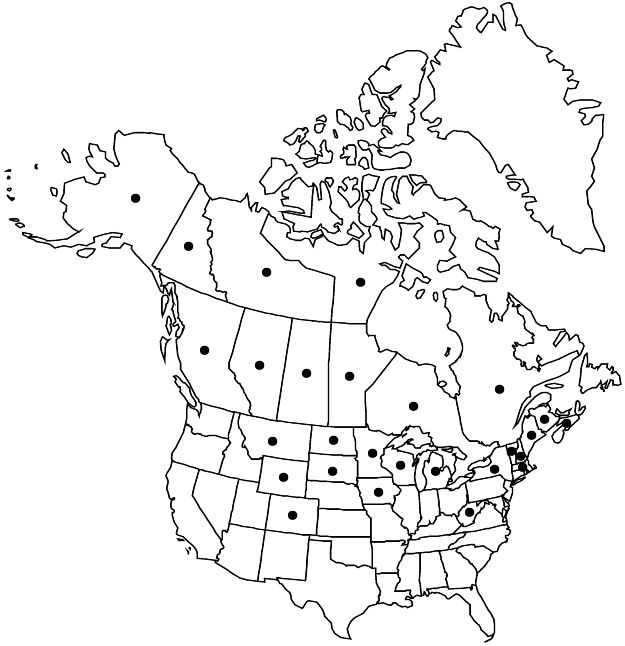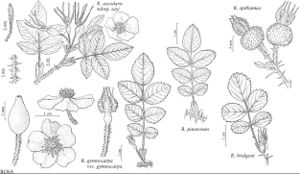Difference between revisions of "Rosa acicularis subsp. sayi"
Brittonia 11: 19. 1959.
FNA>Volume Importer |
RevisionBot (talk | contribs) m (Bot: Adding category Revised Since Print) |
||
| (8 intermediate revisions by 3 users not shown) | |||
| Line 13: | Line 13: | ||
}}{{Treatment/ID/Special_status | }}{{Treatment/ID/Special_status | ||
|code=F | |code=F | ||
| − | |label= | + | |label=Illustrated |
}} | }} | ||
|basionyms={{Treatment/ID/Basionym | |basionyms={{Treatment/ID/Basionym | ||
|name=Rosa sayi | |name=Rosa sayi | ||
|authority=Schweinitz | |authority=Schweinitz | ||
| + | |rank=species | ||
|publication_title=in W. H. Keating, Narrat. Exp. St. Peter's River | |publication_title=in W. H. Keating, Narrat. Exp. St. Peter's River | ||
|publication_place=2: 388. 1824 | |publication_place=2: 388. 1824 | ||
| Line 24: | Line 25: | ||
|name=R. acicularis var. bourgeauiana | |name=R. acicularis var. bourgeauiana | ||
|authority=Crépin | |authority=Crépin | ||
| + | |rank=variety | ||
}} {{Treatment/ID/Synonym | }} {{Treatment/ID/Synonym | ||
|name=R. butleri | |name=R. butleri | ||
| − | |authority= | + | |authority= |
| + | |rank=species | ||
}} | }} | ||
|hierarchy=Rosaceae;Rosaceae subfam. Rosoideae;Rosaceae tribe Roseae;Rosa;Rosa subg. Rosa;Rosa sect. Rosa;Rosa acicularis;Rosa acicularis subsp. sayi | |hierarchy=Rosaceae;Rosaceae subfam. Rosoideae;Rosaceae tribe Roseae;Rosa;Rosa subg. Rosa;Rosa sect. Rosa;Rosa acicularis;Rosa acicularis subsp. sayi | ||
| Line 42: | Line 45: | ||
|elevation=100–2500 m | |elevation=100–2500 m | ||
|distribution=Alta.;B.C.;Man.;N.B.;N.W.T.;N.S.;Nunavut;Ont.;Que.;Sask.;Yukon;Alaska;Colo.;Iowa;Maine;Mass.;Mich.;Minn.;Mont.;N.H.;N.Y.;N.Dak.;S.Dak.;Vt.;W.Va.;Wis.;Wyo. | |distribution=Alta.;B.C.;Man.;N.B.;N.W.T.;N.S.;Nunavut;Ont.;Que.;Sask.;Yukon;Alaska;Colo.;Iowa;Maine;Mass.;Mich.;Minn.;Mont.;N.H.;N.Y.;N.Dak.;S.Dak.;Vt.;W.Va.;Wis.;Wyo. | ||
| − | |discussion=<p>Southern limits of < | + | |discussion=<p>Southern limits of <i></i>subsp.<i> sayi</i> occur in the Rocky Mountains of Colorado, Black Hills of South Dakota, and algific slopes of talus or broken rock covering ice caves in northeastern Iowa, southwestern Wisconsin, Ice Mountain of West Virginia, and mountainous regions of New England where habitats similar to more northern ecosystems exist. Among these outlying populations, the density of stem prickles and aciculi often decreases and fertile branches rarely may be devoid of most armature. In central Canada and northward to Alaska, sepals have relatively small, short stipitate glands on abaxial surfaces more commonly than farther south, where they are more or less eglandular.</p><!-- |
| − | --><p>Plants with the morphological features of < | + | --><p>Plants with the morphological features of <i></i>subsp.<i> sayi</i> also exist in eastern Siberia; confirmation of their identity depends on ploidy levels (W. H. Lewis 1958).</p><!-- |
| − | --><p>Branches of < | + | --><p>Branches of <i></i>subsp.<i> sayi</i>, as well as of <i>Rosa nutkana </i>subsp.<i> macdougalii</i> and <i>R. woodsii </i>subsp.<i> ultramontana</i>, were used as cleansing agents and disinfectants, especially at times of illness and death, by the Shuswap people of interior British Columbia. The branches were placed around houses to prevent diseases in corpses from spreading to others; they were also used to disinfect rooms, clean air, and keep bad spirits away. People also used solutions made from rose bushes for steaming and cleansing in sweathouses. Root solutions were used to treat burns by soaking the burned area, which healed well without blistering or scarring. Hips and branches were boiled and decoctions drunk as medicine for treating diarrhea and upset stomach; teas made from branches were drunk to protect oneself from anything bad (N. J. Turner, pers. comm.).</p> |
|tables= | |tables= | ||
|references= | |references= | ||
| Line 53: | Line 56: | ||
-->{{#Taxon: | -->{{#Taxon: | ||
name=Rosa acicularis subsp. sayi | name=Rosa acicularis subsp. sayi | ||
| − | |||
|authority=(Schweinitz) W. H. Lewis | |authority=(Schweinitz) W. H. Lewis | ||
|rank=subspecies | |rank=subspecies | ||
| Line 67: | Line 69: | ||
|publication title=Brittonia | |publication title=Brittonia | ||
|publication year=1959 | |publication year=1959 | ||
| − | |special status=Endemic; | + | |special status=Endemic;Illustrated |
| − | |source xml=https:// | + | |source xml=https://bitbucket.org/aafc-mbb/fna-data-curation/src/2e0870ddd59836b60bcf96646a41e87ea5a5943a/coarse_grained_fna_xml/V9/V9_171.xml |
|subfamily=Rosaceae subfam. Rosoideae | |subfamily=Rosaceae subfam. Rosoideae | ||
|tribe=Rosaceae tribe Roseae | |tribe=Rosaceae tribe Roseae | ||
| Line 78: | Line 80: | ||
}}<!-- | }}<!-- | ||
| − | -->[[Category:Treatment]][[Category:Rosa acicularis]] | + | --> |
| + | |||
| + | [[Category:Treatment]] | ||
| + | [[Category:Rosa acicularis]] | ||
| + | [[Category:Revised Since Print]] | ||
Latest revision as of 20:33, 6 November 2020
Leaves: stipule auricles 4–7 mm wide; petiole and rachis usually with pricklets; leaflets 5–7, margins 1–2-dentate-serrate, teeth 10–25 per 1/2 blade, gland-tipped, abaxial surfaces usually eglandular, sometimes glandular. Pedicels usually eglandular, if stipitate-glandular, not to apex or mostly sparse. Sepals usually 3+ mm wide at bases, abaxial surfaces eglandular, sometimes sparsely stipitate-glandular. 2n = 42.
Phenology: Flowering Jun–Jul.
Habitat: Meadows, moist forest edges, flood plains, forested uplands, sandy aspen slopes, hillsides, calcareous ridges, banks of bogs and streams, dry sandy ridges, clearings in woods, roadsides, ravines
Elevation: 100–2500 m
Distribution

Alta., B.C., Man., N.B., N.W.T., N.S., Nunavut, Ont., Que., Sask., Yukon, Alaska, Colo., Iowa, Maine, Mass., Mich., Minn., Mont., N.H., N.Y., N.Dak., S.Dak., Vt., W.Va., Wis., Wyo.
Discussion
Southern limits of subsp. sayi occur in the Rocky Mountains of Colorado, Black Hills of South Dakota, and algific slopes of talus or broken rock covering ice caves in northeastern Iowa, southwestern Wisconsin, Ice Mountain of West Virginia, and mountainous regions of New England where habitats similar to more northern ecosystems exist. Among these outlying populations, the density of stem prickles and aciculi often decreases and fertile branches rarely may be devoid of most armature. In central Canada and northward to Alaska, sepals have relatively small, short stipitate glands on abaxial surfaces more commonly than farther south, where they are more or less eglandular.
Plants with the morphological features of subsp. sayi also exist in eastern Siberia; confirmation of their identity depends on ploidy levels (W. H. Lewis 1958).
Branches of subsp. sayi, as well as of Rosa nutkana subsp. macdougalii and R. woodsii subsp. ultramontana, were used as cleansing agents and disinfectants, especially at times of illness and death, by the Shuswap people of interior British Columbia. The branches were placed around houses to prevent diseases in corpses from spreading to others; they were also used to disinfect rooms, clean air, and keep bad spirits away. People also used solutions made from rose bushes for steaming and cleansing in sweathouses. Root solutions were used to treat burns by soaking the burned area, which healed well without blistering or scarring. Hips and branches were boiled and decoctions drunk as medicine for treating diarrhea and upset stomach; teas made from branches were drunk to protect oneself from anything bad (N. J. Turner, pers. comm.).
Selected References
None.
